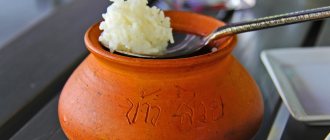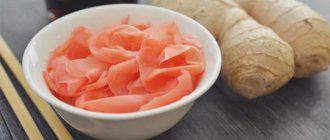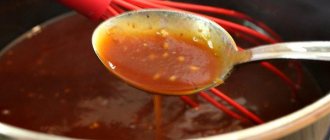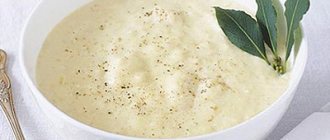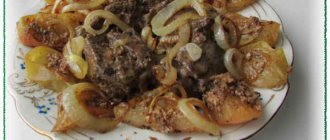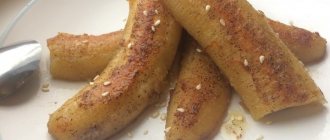Would it be correct to compare wasabi with vigorous Russian horseradish? Botanists will answer in the affirmative, because Eutrema japonicum, the plant from which wasabi sauce is prepared, is directly related to horseradish and cabbage.
Unlike its Russian relatives, this amazing root is grown not in gardens, but on mountain slopes. In order to obtain the burning root, the Japanese carefully arrange terraces, placing them close to mountain streams. Clean water and mountain air give the plant an extraordinary taste and strength.
The process of growing a plant is labor-intensive and long. First, the seeds are germinated in greenhouses, then transferred to prepared terraces. The root grows for a long time, adding 2-3 centimeters per year. It takes four years for a small seed to grow into a beautiful, strong and ready-to-use wasabi root. The plant is collected manually so that not a single root is damaged. Only whole and fresh roots are suitable for making the famous hot sauce.
Real or fake wasabi
Real wasabi sauce is called "Honwasabi" in Japan. It is prepared from roots grown according to all the rules. The seasoning that we buy in supermarkets is grown on an industrial scale in ordinary irrigated fields. In terms of taste, it is far from “Honwasabi”.
The classic act of serving sauce is as magical as growing it. If you go to a Japanese restaurant, you will see the chef carefully grating the root onto dried shark skin directly onto the plate. The master measures out exactly as much wasabi as is necessary for a harmonious combination with the main dish.
On store shelves you can find a similar product from different countries, where it is prepared from mustard powder, horseradish and other ingredients. They have nothing to do with the real Japanese culinary miracle. We offer you a wasabi sauce recipe that you can prepare at home.
Is there wasabi in Russia
Wasabi is prepared quite rarely in Japan - the spice is very expensive and is served only in expensive restaurants. On the territory of our country the situation is different - it is almost possible to find an original product.
The analogue has a soft color and less pungency than the original. This is what wasabi, served in catering establishments, consists of:
- The main ingredient is daikon. The vegetable is white, so it needs to be tinted with green food coloring;
- Salt, sugar and water;
- Cornstarch and soy flour;
- Sorbitol and turmeric;
- Rapeseed oil, acidifiers and flavorings.
We also recommend: Why do you want butter?
Wasabi paste contains 2% (or less) of the real thing! Cafes and restaurants serve paste from a tube - this is a convenient packaging format that can be purchased in most large stores.
Were you surprised when you found out what wasabi is made from? This is what we were counting on! Want to create magic in the kitchen yourself? Next, we will tell you in detail how to make wasabi from dry powder.
Wasabi recipe
It would be great if you can somehow get your hands on fresh wasabi root. Then all you have to do is grate it on a fine grater, roll it into a ball, and let it sit for about 15 minutes, then you can serve it with dishes. We don’t have the root, so we will prepare the seasoning from powder, which can be purchased in the store. For the sauce we need to take:
- wasabi powder – 1 tablespoon;
- clean water - 2 tablespoons.
Preparation:
- Simply mix the powder and water until smooth. Then we form a ball and transfer it to a plate with a side dish.
Please note that freshly prepared seasoning should be consumed immediately; if stored for a long time, it loses its taste and pungency.
Homemade wasabi with horseradish and lemon juice
Ingredients:
- 1 tsp. wasabi powder
- 1 tsp. cold water
- 1/3 tsp. soy sauce
- 1/2 tsp. grated horseradish
- 3 drops lemon juice
Preparation:
- Add wasabi powder, water, soy sauce to a glass and mix thoroughly.
- Add horseradish to the mixture and add lemon juice. Stir again until smooth.
- Wait 10 minutes for the seasoning to acquire its original aroma and harden a little.
- After this, serve to the table with Japanese cuisine.
Important! Don’t even think about stirring wasabi in soy sauce—it’s against Japanese tradition. In the Land of the Rising Sun, they do this: they put a drop of wasabi on the sushi, and then dip the side of the fish into soy sauce. Which is what we recommend for you too.
Whatever wasabi recipe you use, the prepared paste cannot be stored for a long time at home, as its pungency and aroma decrease over time. After 2-3 days, the sauce loses much of its taste and is significantly different from freshly prepared.
As a bonus, we will present a recipe that has nothing to do with real wasabi, but received the humorous name “wasabi in Russian” due to its burning taste and emerald hue.
Horseradish and mustard wasabi
If you have no opportunity to get your hands on an exotic root, don’t worry. The sauce can be made from ingredients that are familiar to us. We will need:
- mustard (powder) – 50 grams;
- horseradish root (grated) – 50 grams;
- green food coloring – 5 grams.
Preparation:
- Wash the horseradish root, peel it, grate it, and measure out 50 grams.
- Mix horseradish with mustard powder to obtain a homogeneous consistency.
- Add coloring to the mixture to give the sauce its natural color.
The paste turns out thick and quite spicy.
Beneficial features
Wasabi sauce, the recipe for which we will discuss later in the article, has been used by Easterners for centuries as a natural antidote. According to observations, consumption of the product reduces the risk of food poisoning from thermally unprocessed food components. This is confirmed by the relevant results of scientific research.
Wasabi produces an antiseptic and antifungal effect on body tissue. Thanks to the use of hot sauce, stimulation of the production of gastric juices is noted. For this reason, overeating on food is not recommended for people who suffer from the development of diseases of the digestive system.
Eastern healers often use the product to create compresses that relieve discomfort from arthritis and neuralgia. Wasabi contains an abundance of antioxidants that neutralize the dangerous effects of free radicals on the body.
The sauce is a source of biologically active substances isothiocyanates. These elements suppress the activity of pathogenic bacteria in the oral cavity. There is a beneficial effect of burning paste on tooth enamel. The Japanese claim that regular consumption of wasabi significantly reduces the likelihood of developing caries.
Mayonnaise with wasabi
Based on wasabi, many housewives prepare amazing mayonnaise, which is perfect for shrimp, refreshes them and adds a pleasant spice. For preparation we will need:
- wasabi powder – 1-2 tablespoons;
- vegetable oil (odorless) – 200 ml;
- egg - 1 piece;
- lemon juice – 1.5 tablespoons;
- boiled water (room temperature) – 1-2 tablespoons;
- pepper and salt to taste.
Cooking process:
- Take a deep bowl, pour oil into it and beat in the egg.
- Dilute wasabi powder with water to a paste. The consistency should be smooth.
- Place the resulting paste in a bowl with butter and egg. Take a blender and beat all the ingredients. Please note that wasabi mayonnaise thickens quickly, in just a few seconds.
- Add lemon juice, pepper and salt to the whipped mixture. Knead again by hand. The seasoning is ready.
This wasabi sauce goes well with shrimp and other seafood.
Use in cosmetology
Wasabi is not only a tasty and piquant spice, but also an excellent cosmetology product for the skin of the face and body. The substances contained in the spice actively fight free radicals, the main cause of aging in the body. In many beauty salons, wasabi is used in procedures that help cope with cellulite. The spice helps improve blood circulation, relieve vascular spasm and reduce joint pain. A scrub made with wasabi helps cleanse the skin of dead cells, making it even and smooth.
Wasabi is an excellent facial skin care product. To give the skin a slight blush and restore tone, you should prepare the following mask. Mix a small handful of wasabi powder with one yolk until smooth. Then add a teaspoon of rice flour and stir well again so that there are no lumps. Apply the prepared skin product to a clean, damp face. After ten minutes, the mask will need to be washed off with either warm or cool water.
When applying this product to your face, you should avoid getting the mask into your eyes, lips or nasolabial folds, since the skin in these places is very sensitive. It is also necessary to wait a while with the mask if there are wounds or cracks on the skin so as not to heat it.
Some women mix wasabi with lip balm to give their lips a little volume. As a result, the lips become slightly plump. However, experts in the beauty industry do not recommend using this product often, as it leads to slight swelling of the lips.
In addition, wasabi is also used to prepare hair masks. Wasabi powder is very effective for hair growth and against hair loss. To do this, you need to pour one teaspoon each of dry ginger powder and wasabi powder with half a glass of hot rice vodka and put it in a fairly warm and dark room to infuse for about twenty-one days. The infusion should be shaken at least once every three days. After the specified period of time, the infusion must be decanted. Before applying the product to the scalp, you need to dilute a teaspoon of this infusion with green tea so that it does not get too hot. A wasabi hair mask should be rubbed into the hair roots overnight. The procedure must be performed every other day for three months.
Wasabi seasoning can also be used for weight loss. At least once a week, you can do a fasting day on a sushi diet using wasabi, since sushi is considered a filling product with a minimal calorie content. Nutritionists have developed the following one-day diet:
- four meals a day;
- a serving consists of two homemade rolls;
- eat with wasabi;
In one such fasting day you can lose more than one kilogram.
What dishes is the sauce served with?
In Japan, wasabi is an indispensable culinary attribute, served with sushi and rolls. However, its combination with dishes does not end there. The sauce amazingly colors the taste of small fried fish, which is used as a cold appetizer.
Spicy condiment lovers will love the sandwich slathered in a thin layer of rich green sauce. Add slices of delicious smoked mackerel to the bread and sauce, a little cream cheese and thin slices of tomatoes, and you get an original sandwich with a multifaceted spicy-smoky taste.
The powder can be used to make an unusual salad dressing if you dilute it with plenty of water. Japanese gourmets easily season their ice cream with it.
Origin story
The plant of the same name, on the basis of which traditional hot sauce is prepared, has been known since the end of the 10th century. However, the product became widespread in the 30s of the last century. It was during this period that culinary specialists from the Shizuoka region of Japan began serving savory dishes to the table of the local shogun. The ruler of the lands liked the spicy paste of an interesting greenish hue. Soon the sauce began to be widely used as an addition to various national dishes.
Wasabi root began to be collected throughout Japan. In addition to the original taste and a number of interesting gastronomic combinations, residents of the country were interested in the healing properties of the product. The local population came to the conclusion that the sauce perfectly disinfects the ingredients of dishes that are served raw. Wasabi began to be used as an addition to fish and seafood.
